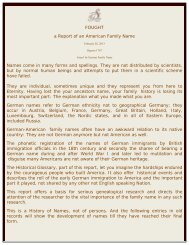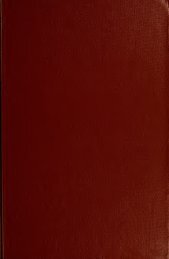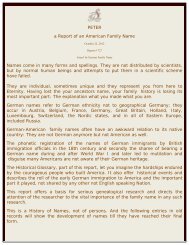Reasoner - German Genealogical Services
Reasoner - German Genealogical Services
Reasoner - German Genealogical Services
You also want an ePaper? Increase the reach of your titles
YUMPU automatically turns print PDFs into web optimized ePapers that Google loves.
Surname Nee First Name Middle Name Born Sex Ilit R Speeling Variations From To NotesReisener Tobias MShip311 Montague Ship 1773-12-08 William Pickels L-P 26Surname Nee First Name Middle Name Born Sex Ilit R Speeling Variations From To NotesRissner Jacob MShip315 Union Ship 1774-09-30 Andrew Bryson R-C-P 131Surname Nee First Name Middle Name Born Sex Ilit R Speeling Variations From To NotesReutzheiner Johan Carl MShip413 Mary Brig 1788-08-05 Ams-PhaSurname Nee First Name Middle Name Born Sex Ilit R Speeling Variations From To NotesRitzener Mararethe FBrigBilanderBrigGalleyA Bilander, also spelled billander or be'landre, was a small European merchant ship with two masts, used in the Netherlands for coastand canal traffic and occasionally seen in the North Sea but more frequently to be seen in the Mediterranean Sea. The mainmast waslateen-rigged with a trapezoidal mainsail, but the foremast carried the conventional square course and square topsail. Displacement wastypically under 100 tons. The Bilander was short-lived, being replaced by more efficient designs, and few examples exist today.In nautical terms, a brig is a vessel with two square-rigged masts. During the Age of Sail, brigs were seen as fast and maneuverable andwere used as both naval war ships and merchant ships. They were especially popular in the 18th and early 19th centuries. Brigs fell outof use with the arrival of the steam ship because they required a relatively large crew for their small size and were difficult to sail into thewind. They are not to be confused with a brigantine which has different.The word "schooner" comes since 1419 from <strong>German</strong> texts. The later meaning galley for a "two-master with high foremast" is notfound before 1748 for the Dutch, Danes, Swedes and <strong>German</strong>s schooner means a vehicle with a rake and his flat tail, which has a largeboom and a small mizzen mast. A distinction is made between Huker Slupgaleasse and, depending on whether the main mast riggedlike the Schooner brigg.A small tender ship, which normally links two ports.PacketPinkShipIn the Atlantic Ocean the word pink was used to describe any small ship with a narrow stern, having derived from the Dutch wordpincke. They had a large cargo capacity, and were generally square rigged. Their flat bottoms (and resulting shallow draught) madethem more useful in shallow waters than some similar classes of ship. They were most often used for short-range missions in protectedchannels, as both merchantmen and warships. A number saw service in the English Navy during the second half of the 17th CenturyGalley:Full rigged ships: The masts of a full rigged ship, from bow to stern, are: • Foremast, which is the second tallest mast • Mainmast, thetallest • Mizzenmast, the third tallest • Jiggermast, which may not be present but will be fourth tallest if so If the masts are of wood,each mast is in three or more pieces. The lowest piece is called the mast or the lower. Above it, the pieces in order are • Topmast •Topgallant mast • Royal mast, if fitted .Most Immigrants arrived with this type








